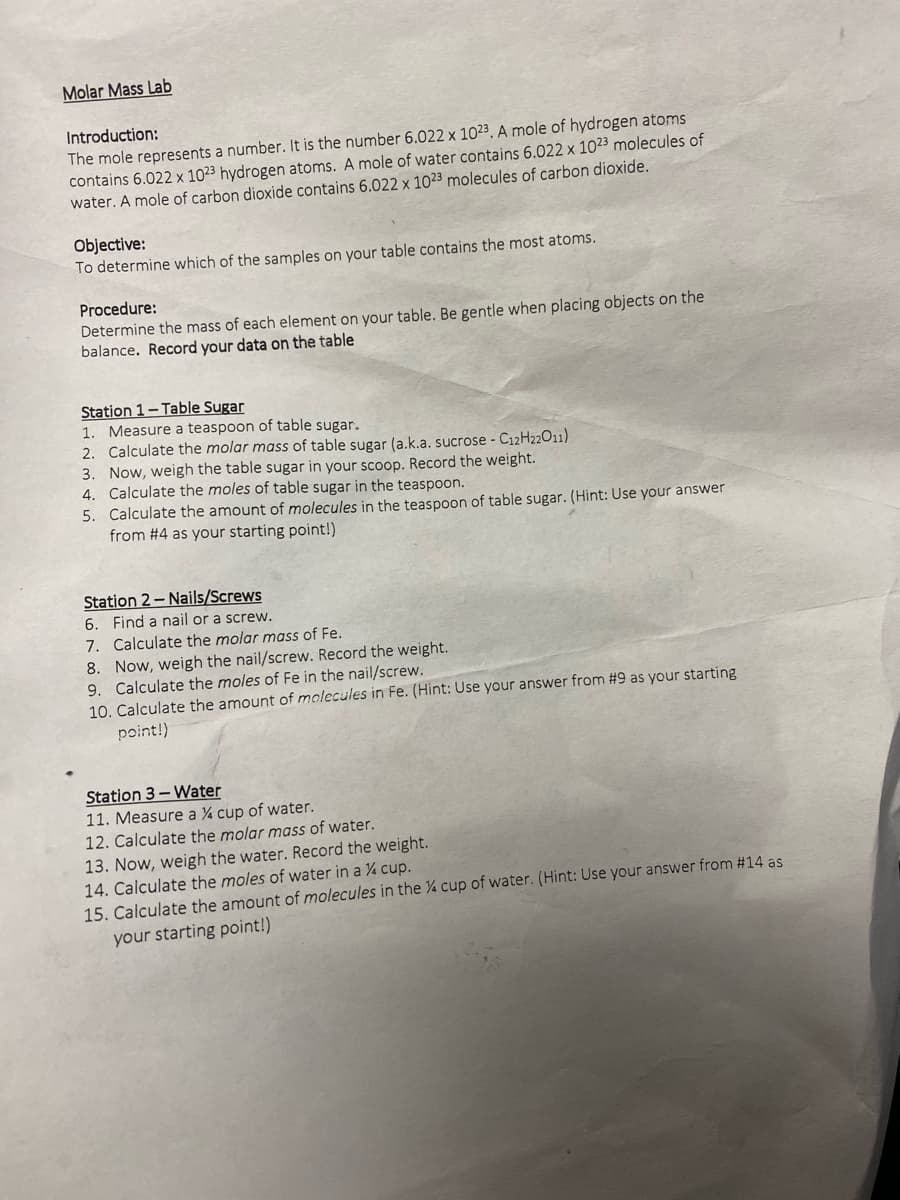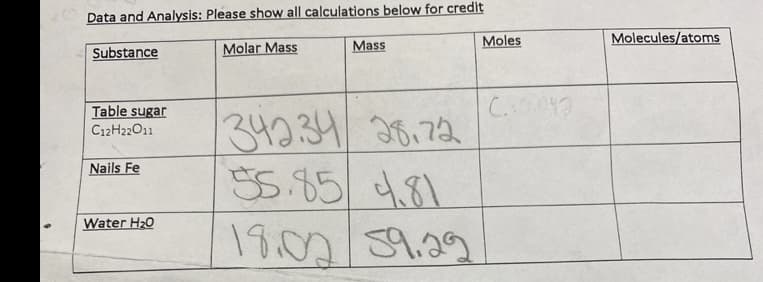Chemistry: Principles and Reactions
8th Edition
ISBN:9781305079373
Author:William L. Masterton, Cecile N. Hurley
Publisher:William L. Masterton, Cecile N. Hurley
Chapter3: Mass Relations In Chemistry; Stoichiometry
Section: Chapter Questions
Problem 74QAP: Magnesium ribbon reacts with acid to produce hydro- gen gas and magnesium ions. Different masses of...
Related questions
Question
How to find moles and molecules/atoms for C12H22O11and FE and H20

Transcribed Image Text:Molar Mass Lab
Introduction:
The mole represents a number. It is the number 6.022 x 1023. A mole of hydrogen atoms
contains 6.022 x 1023 hydrogen atoms. A mole of water contains 6.022 x 1023 molecules of
water. A mole of carbon dioxide contains 6.022 x 1023 molecules of carbon dioxide.
Objective:
To determine which of the samples on your table contains the most atoms.
Procedure:
Determine the mass of each element on your table. Be gentle when placing objects on the
balance. Record your data on the table
Station 1- Table Sugar
Measure a teaspoon of table sugar.
2. Calculate the molar mass of table sugar (a.k.a. sucrose - C12H22O11)
3. Now, weigh the table sugar in your scoop. Record the weight.
4. Calculate the moles of table sugar in the teaspoon.
5. Calculate the amount of molecules in the teaspoon of table sugar. (Hint: Use your answer
from #4 as your starting point!)
1.
Station 2- Nails/Screws
6. Find a nail or a screw.
7. Calculate the molar mass of Fe.
8. Now, weigh the nail/screw. Record the weight.
9. Calculate the moles of Fe in the nail/screw.
10. Calculate the amount of molecules in Fe. (Hint: Use your answer from #9 as your starting
point!)
Station 3- Water
11. Measure a % cup of water.
12. Calculate the molar mass of water.
13. Now, weigh the water. Record the weight.
14. Calculate the moles of water in a % cup.
15. Calculate the amount of molecules in the 4 cup of water. (Hint:
your starting point!)
your answer from #14 as

Transcribed Image Text:Data and Analysis: Please show all calculations below for credit
Moles
Molecules/atoms
Substance
Molar Mass
Mass
Table sugar
C.
34334 36.72
55.85 481
18:029.22
C12H22011
Nails Fe
Water H20
Expert Solution
This question has been solved!
Explore an expertly crafted, step-by-step solution for a thorough understanding of key concepts.
Step by step
Solved in 2 steps with 2 images

Knowledge Booster
Learn more about
Need a deep-dive on the concept behind this application? Look no further. Learn more about this topic, chemistry and related others by exploring similar questions and additional content below.Recommended textbooks for you

Chemistry: Principles and Reactions
Chemistry
ISBN:
9781305079373
Author:
William L. Masterton, Cecile N. Hurley
Publisher:
Cengage Learning

Chemistry: Matter and Change
Chemistry
ISBN:
9780078746376
Author:
Dinah Zike, Laurel Dingrando, Nicholas Hainen, Cheryl Wistrom
Publisher:
Glencoe/McGraw-Hill School Pub Co

Chemistry: Principles and Reactions
Chemistry
ISBN:
9781305079373
Author:
William L. Masterton, Cecile N. Hurley
Publisher:
Cengage Learning

Chemistry: Matter and Change
Chemistry
ISBN:
9780078746376
Author:
Dinah Zike, Laurel Dingrando, Nicholas Hainen, Cheryl Wistrom
Publisher:
Glencoe/McGraw-Hill School Pub Co